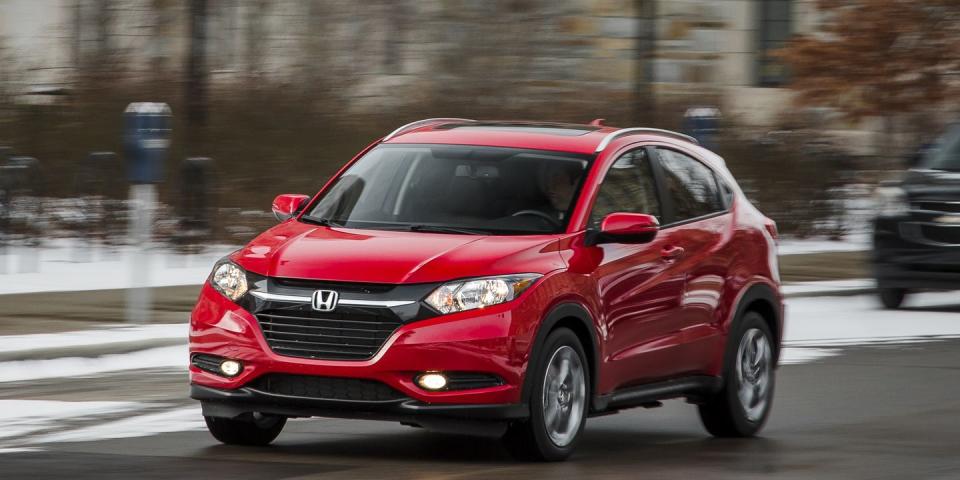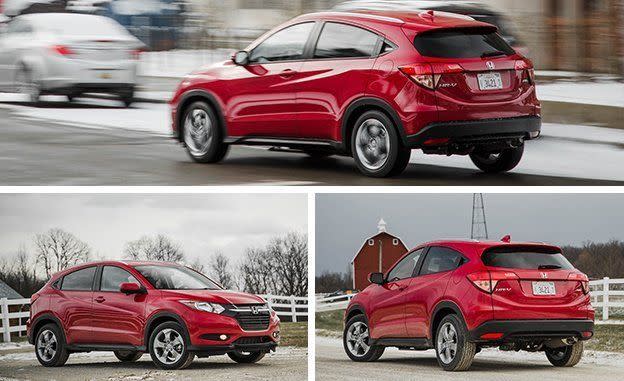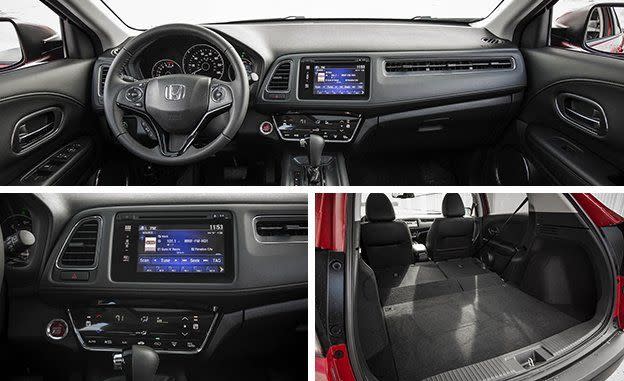Catching Up with the HR-V, Honda's Wee Little Crossover

Overview: What Honda takes its chassis from the Fit, its engine from the previous-generation Civic, and its naming convention from the CR-V? If you answered the Honda HR-V, you’re today’s lucky winner. As the smallest Honda crossover, the HR-V is essentially a slightly larger and higher-riding version of the Fit hatchback with available all-wheel drive and more SUV-like styling. Launched in 2015, the HR-V competes with other subcompact crossovers such as the Jeep Renegade and the Mazda CX-3. It comes standard with front-wheel drive and a manual transmission, the latter of which is a rarity among SUVs and crossovers. A continuously variable automatic is an option, and it’s the only transmission choice if you opt for the $1300 all-wheel-drive system. LX, EX, and EX-L trim levels are available and are priced between $20,000 and $27,000, less than some competitors, which can reach past $30,000.
What’s New: The HR-V is only in its second model year, so changes for 2017 are minimal and include a new silver exterior color and a $250 price hike across the board. Those with a keen eye for fuel economy may also notice that EPA ratings are slightly different for 2017, with all-wheel-drive HR-Vs losing 1 mpg in the highway test. This is not due to any mechanical changes, but rather to the EPA’s stricter enforcement of testing procedures that affected ratings for many 2017-model-year vehicles.

What We Like: The HR-V’s practical and configurable interior is its greatest asset, providing more cargo space (up to 59 cubic feet behind the front row with all seats folded) than many larger SUVs. Rear-seat room is plentiful, and the seats flip and fold in numerous ways to accommodate lots of different types of cargo. Honda positioned the fuel tank under the front seats to achieve this spacious versatility.
The 1.8-liter four-cylinder provides fuel-economy ratings near the top of its class, with front-wheel-drive CVT models achieving a combined rating of 31 mpg. In our 75-mph real-world highway fuel-economy test, an all-wheel-drive HR-V returned 30 mpg, 1 mpg below its EPA highway rating. (Front-wheel-drive CVT models are rated at 34 mpg highway.) Passing on the optional CVT and sticking with the six-speed manual means saving $800 and losing a few mpg, but it’d be our choice anyway because of the satisfaction of shifting ourselves and the increased fun factor. Rather than limiting the stick shift to the base trim level, Honda also offers the six-speed on the mid-level EX trim, which means heated seats, a sunroof, automatic climate control, and push-button start are included.

What We Don’t Like: Unrefined and slow, the HR-V provides a lackluster driving experience that doesn’t measure up to expectations set by its Honda pedigree. The 1.8-liter four-cylinder’s 141 horsepower is not up to the task of moving the 3000-pound HR-V with any alacrity, especially when burdened with the extra weight of the optional all-wheel-drive system: We measured a lengthy zero-to-60-mph time of 9.5 seconds. Although the manual transmission helps acceleration somewhat (zero to 60 in 8.4 seconds), most HR-Vs are sold with the optional CVT automatic, which modulates engine speed in a way that exaggerates the four-cylinder’s coarse and unpleasant character. Overly light steering and a softly tuned suspension mean that the HR-V doesn’t feel as proficient on the road as competitors including the CX-3 and the Renegade. The HR-V’s disappointing dynamics are made even more so when one considers the excellence found in the same showroom in the form of the Civic, the Accord, and the latest CR-V.
Also lacking is the HR-V’s technology. Active-safety features such as forward-collision warning and blind-spot monitoring are not offered at all, although a backup camera is standard and Honda’s LaneWatch side-camera system is standard on EX and EX-L trim levels. Those two models also come with a 7.0-inch display screen that’s frustrating to use due to its slow operation and overreliance on silly touch-capacitive buttons; it also lacks Apple CarPlay and Android Auto smartphone integration functions. We think it best to stick with the base LX model, which still offers features including Bluetooth and a backup camera but uses a smaller, simpler touchscreen with real volume and tuning knobs.
BUILD YOUR OWN | RANK IN SEGMENT
You Might Also Like

 Yahoo Autos
Yahoo Autos 